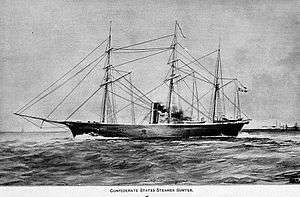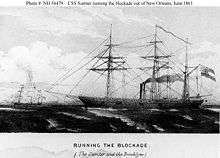CSS Sumter
CSS Sumter, converted from the 1859-built merchant steamer Habana, was the first steam cruiser in the Confederate States Navy. She operated against American shipping between July and December 1861, taking 18 prizes, but was trapped in Gibraltar by Union warships. Decommissioned, she was sold and reverted to merchant service as Gibraltar. She successfully ran the Union blockade in 1863 and survived the war.
 CSS Sumter | |
| History | |
|---|---|
| Laid down: | 1859 |
| Christened: | Habana |
| Acquired: | April 1861 |
| Commissioned: | 3 June 1861 as CSS Sumter |
| Fate: | Sold 19 December 1862 (Renamed Gibraltar). Reportedly sunk in English Channel 1867 |
| General characteristics | |
| Displacement: | 473 tons |
| Length: | 184 ft (56 m) |
| Beam: | 30 ft (9.1 m) |
| Draft: | 12 ft (3.7 m) |
| Propulsion: | Steam, Sail |
| Speed: | 10 knots (19 km/h; 12 mph) |
| Complement: | 18 |
| Armament: |
|
Construction and merchant service
The wood-hulled merchant steamship Habana was built in 1859 at the Philadelphia shipyard of Birely & Lynn for Captain James McConnell's New Orleans & Havana Steam Navigation Co.[1][2][Note 1] She was powered by a 400 horsepower engine made by Neafie, Levy & Co, also of Philadelphia, driving a single propeller and was also rigged for sail, generally described as bark rigged. She was variously reported to measure 499 or 520 gross registered tons, and had dimensions 163 ft (50 m), 23 ft (7.0 m) beam and 12 ft (3.7 m) depth.[2][3] Habana was launched on 18 May 1859, performed well on trials and was considered a fast ship in subsequent mail service out of New Orleans.[2]
She was later rigged as a three-masted bark, and renamed Gibraltar or Gibraltar of Liverpool.
Confederate States Navy

The merchant steamship Habana was purchased by the Confederate Government at New Orleans in April 1861; she was converted to a cruiser and placed under the command of Raphael Semmes. Renamed Sumter, she was commissioned in the Confederate Navy on 3 June 1861 and broke through the Federal blockade of the Mississippi River mouth late in that month.
Eluding the sloop-of-war USS Brooklyn which was in hot pursuit, early in July, the pioneering Confederate Navy commerce raider captured eight U.S.-flagged merchant ships in waters near Cuba, then moved to the south to Maranhão, Brazil coast where she took two more. Two additional merchantman fell to Sumter in September and October 1861. While coaling at Martinique in mid-November, she was blockaded by the Federal sloop of war Iroquois, but was able to escape to sea at night and resume her activities. Sumter captured another six ships from late November into January 1862, while cruising from the western hemisphere to European waters. Anchoring at Cadiz on 4 January 1862, she was allowed only to make necessary repairs there, without refueling, and was forced to run for Gibraltar.
Unable to obtain needed repairs, she was laid up in April and remained inactive, watched through the year by a succession of U.S. Navy warships, among them the sloop of war USS Kearsarge and gunboat Chippewa. Semmes and many of her officers were reemployed in the new cruiser CSS Alabama.
On 17 October, Second Officer Hester shot Commanding officer Andrews with a revolver as Andrews was laying in his bed, killing him. Hester was arrested. A coroner's jury returned a verdict of wilful murder.[4]
Gibraltar
Disarmed and sold at auction 19 December 1862 to the Fraser-Trenholm interests, Sumter quietly continued her service to the Confederacy under British colors as the blockade runner Gibraltar of Liverpool.
Though her career as a warship had lasted barely six months, Sumter had taken 18 prizes, of which she burned eight, released or bonded nine; only one was recaptured. The diversion of Federal blockade ships to hunt her down had been in itself of significant service to the Confederate cause.
As Gibraltar, she ran at least once into Wilmington, North Carolina, under Capt. E. C. Reid, a Southerner. He sailed from Liverpool 3 July 1863 with a pair of 22-ton Blakely guns and other particularly valuable munitions, returning with a full load of cotton. The beginning of this voyage is recorded only because the U.S. Consul at the British port passionately protested Gibraltar's being allowed to sail – ostensibly for Nassau, days before formal customs clearance: "She is one of the privileged class and not held down like other vessels to strict rules and made to conform to regulations." The arrival at Wilmington is also accidental matter of record today because of the troop transport Sumter tragedy at Charleston the same summer, which, until November, Admiral Dahlgren's intelligence understandably confused with the former cruiser Sumter, now Gibraltar.
Mr. Trenholm's son-in-law long maintained Sumter finally "went down in a gale near the spot where the Alabama was sunk," but supplied no date; one source suggests 1867. The last official report of her seems to have been by the U.S. Consul at Liverpool, 10 July 1864: "The pirate Sumter (called Gibraltar) is laid up at Birkenhead."
See also
- Blockade runners of the American Civil War
- Confederate Navy
- Union Navy
- Bibliography of American Civil War naval history
Notes
- "Byerly" probably a mis-spelling
References
- Bishop, J Leander (1868). A History of American Manufactures from 1608 to 1860: Vol III. Philadelphia: Edward Young & Co. p. 67. Retrieved 20 November 2018.
- "More about the Sumter". The New York Times. 3 September 1861. Retrieved 20 November 2018.
- American Lloyd’s Register of American and Foreign Shipping. New York, NY: E & W Blunt. 1861. pp. 546–547. Retrieved 20 November 2018.
- "The Bombay and Mediterranean Mails". Glasgow Herald (7112). Glasgow. 27 October 1862.
Sources
- Semmes, Raphael, The Cruise of the Alabama and the Sumter, Carleton, 1864, Digitized by Digital Scanning Incorporated, 2001, ISBN 1-58218-353-8.
See The Cornhill Magazine, No6 (Jy-Dec 1862) pp187–205: "The Cruise of the Confederate Ship 'Sumter': [From the Private Journal of an Officer]". A swaggering account, unsigned.
- This article contains public domain material from the Naval History and Heritage Command, entry here.